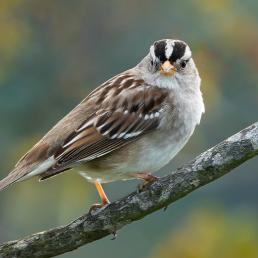

Join BirdNote tomorrow, November 30th!
Illustrator David Sibley and actor H. Jon Benjamin will face off in the bird illustration battle of the century during BirdNote's Year-end Celebration and Auction!
Two-thirds of migrating birds fly at night, making it a challenge to track their movement. Dr. Andrew Farnsworth of Cornell is using a combination of bioacoustics and radar to learn when birds migrate and where they stop, feed, and rest. The acoustics tell what species are migrating at night and where they are. Radar is wonderful at telling how many things are up there. So using the two together is going to add to our ability to forecast and analyze migration and understand what particular stopover habitat and places are important.
BirdNote®
Tracking Migrating Birds with Sound, Sight, and Radar
With Andrew Farnsworth
Written by Todd Peterson
This is BirdNote.
[Flight calls of Swainson’s Thrushes at night]
Listen! Swainson’s Thrushes are calling to one another while flying at night.
[Flight calls of Swainson’s Thrushes at night]
Two-thirds of migrating birds fly at night, making it a challenge to track their movement.
Dr. Andrew Farnsworth, a researcher at the Cornell Lab of Ornithology, is using advances in technology to learn when birds migrate and where they stop, feed, and rest.
“We’re using bioacoustics and radar together, as well as observational data from people …and meteorological data and…really, combining all of these things together. The acoustics tells you very well about what species are migrating at night…and where they are. But…a single microphone, for example, is very poor at telling you how many individuals, because one bird may call multiple times; and some birds are not calling. Radar, on the other hand, is wonderful at telling you how many things are up there. How many birds? Where are they? How fast are they moving? What direction are they going? …So using the two things together, and understanding how they relate to one another…is a really exciting frontier that in the next few years is going to have some tremendous power in terms of our ability to forecast and analyze how migrants pass through a space, where they are when and what particular stopover habitat and places are important.”
[Flight calls of Swainson’s Thrushes at night]
To hear flight calls and see radar representing millions of birds on the move, begin at our website, birdnote.org.
###
Flight calls of Swainson’s Thrushes flying at night, 17 October 2010, 4AM, over Santa Barbara Island, Channel Islands National Park, California, provided by Information Science Program and Conservation Science Program at the Cornell Lab of Ornithology, Ithaca, New York. Calls recorded autonomously by a Song Meter SM2 deployed by Michael Powers and Nick Lethaby.
Interview Marantz III T246
Producer: John Kessler
Executive Producer: Chris Peterson
© 2012 Tune In to Nature.org September 2012 Narrator: Mary McCann
ID# bioacoustics-01-2012-09-18 bioacoustics-01




